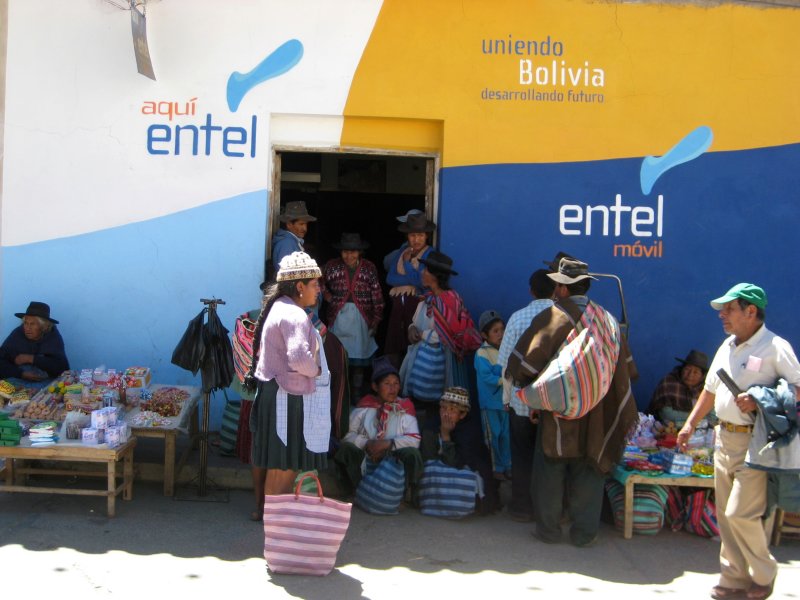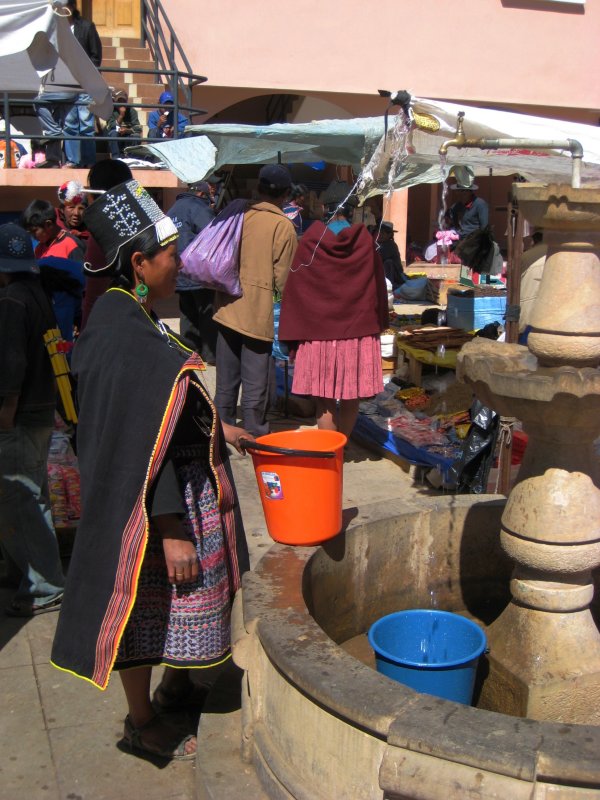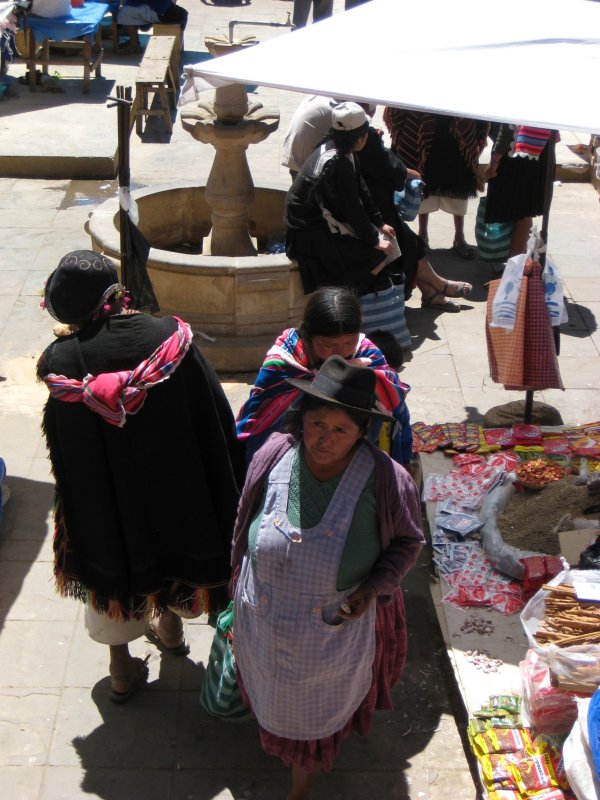雲遊四海
旅行應該是每次隻走一兩公尺,同一個物件,同一個景色,從不同的角度去觀察她,欣賞她。玻利維亞風情(3),絢麗的集市
早在去玻利維亞以前,我就計劃好了要去趟Tarabuco,而且還必須在星期天到,為的就是看一下那裏的星期天集市,所以整個的行程安排不得不全圍繞著這個目標轉。
Tarabuco 離Sucre大約六十多公裏的地方,開車需要一個半小時。那裏星期天的集市是整個玻利維亞最有特色的風景之一。

Tarabuco 的郵電局,等著打電話的人排到了門外。
逛集市一直是我旅行的重要節目之一,最好是那種沒什麽遊客,都是本地人的集市,弄一杯當地人的飲料,來個當地人的小吃,要不討討價,要不看看人發呆。當然,凡是上了旅行指南的,遊客不多的集市已經不多見了,但Tarabuco仍然是玻利維亞看當地人習俗的最好地方。
玻利維亞的少數民族最主要的是Aymara和Quechua,他們都生活在高原地帶。比如玻利維亞南部Potosi的礦工們許多都是Quechua。而和秘魯交界的Lake Titicaca周圍,玻利維亞西部,許多則是Aymara人。當人們提到印加(Inca)文化的時候,其文化的根源就是由Aymara和Quechua人的傳統文化所組成的。Ayamara和Quechua主要分布在秘魯和玻利維亞。
而Tarabuco是玻利維亞的少數民族Yampara聚集的地方。這是一個人口相對比較少的少數民族。和世界上所有的少數民族一樣,我們往往從他(她)們的服飾就可以很容易的區分出來。

Yampara男人的傳統帽子和服飾,Tarabuco
到五彩繽紛的Tarabuco,就做三件事:看人和他(她)們絢麗服飾,看Yampara的編織(weaving),喝點小酒。

廣場上的Yampara男人,Tarabuco

菜市場裏(1),Tarabuco

接水的少婦,Tarabuco

街上的行人,Tarabuco

菜市場裏(2),Tarabuco
Yamapara人最拿手的就是編織,古老的編織藝術始終是Yamapara人生活中很重要的一部分。它的色彩和圖案也無不反映出當地土著人的生活和他們的個性。所以,去Tarabuco旅行的人都會買些編織品。雖說由於遊客的激增,那些價錢的膨脹已經遠遠超過當地人所能接受的。但和玻利維亞其他的城市尤其是拉巴斯比,這裏的編織品還是便宜很多。

集市裏的攤位,Tarabuco
去Tarabuco還有要做的是嚐嚐他們的Chicha。不象大規模生產的Chicha,在集市裏,那裏的Chicha都是小作坊裏製成的。Chicha算是土生土長的南美洲啤酒,它是由木薯,玉米作為主要原料的,由於酒精含量隻有1~3%,也可以說是非酒精的飲料。也有的加入些水果,也有的不經過發酵(完全沒有酒精)。不僅在玻利維亞,整個南美洲都有各種各樣不同配方的Chicha。喝Chicha也是印加人許多節日和宗教儀式中不可缺少的一部分。請記住,在喝Chicha以前,別忘了先在地上灑一點,祭祀Mama Sara(玉米娘娘),就像在造房子的時候,別忘了在地基下埋一個曬幹了的llama的胎畜,然後房頂上放一個Chicha的瓶子,讓大地母親保佑全家好運和平安。
在Sucre的Café Amsterdam,Lisa和她的誌願者們還發行了一篇雜誌,孩子們的畫畫,寫作,餐館裏的菜譜,寓言故事。西班牙文和英文對照的,學西班牙文的最好方法。這裏我把它抄了下來,把西班牙文,英文,和中文都列了出來。
從寓言故事學西班牙語。
"El Zorro y el Conejo"
Cierta manana un conejo estaba tomando solcito apoyado a una pared, de repente la pared quiso caerse por el peso del conejo.
El zorro al ver al conejo, quiso comerselo, pero el conejo, siendo mas inteligente, le dijo: “Estoy sosteniendo la pared que se esta queriendo caerse”.
Entonces el conejo y el zorro se pusieron de acuerdo en que el zorro buscara algun objeto para poder sostener la pared y asi no se caiga.
El zorro fue corriendo en busca del objeto para que sostuviera la pared, pensando en comer al conejo despues de encontrar el objeto, Volvio rapido y mientras ponia el palo que iba a sostener la pared, el conejo se escapo.
El zorro, molesto por el engano del conejo se fue en busca de el.
En la tarde lo encontro al conejo queriendo sacar tunas para comer. Le dijo: “Ahora, si, te comere y ya no me enganaras”. El conejo dijo: “Que mala suerte, la tuna es mas rica que yo”. Entonces el zorro corrio a sacar tunas mientras que el conejo se eacapo, pero lo peor es que el zorro se lleno de sus espinas.
"The fox and the rabbit"
One morning, a rabbit was leaning against the wall enjoying the sun. Suddenly, the wall started to collapse because of the weight of the rabbit.
When the fox saw the rabbit, he decided he wanted to eat it, but, the rabbit, who was smarter, said to him, "I am holding the wall that is going to fall over."
So, the rabbit and the fox agreed that the fox would go and get something to hold the wall up so that it would not fall.
The fox ran to find an object to hold the wall, thinking that he would eat the rabbit when he found it. He came back very soon and while he was placing the stick that would hold the wall, the rabbit escaped.
The fox, irritated by the rabbit's trick, went to look for him.
He found him in the afternoon picking tunas(a kind of cactus) to eat. He said, "Now, I will eat you and you won't trick me again." The rabbit said, "This's unlucky, tunas taste better than I do." So, the fox went to get tunas while the rabbit escaped, but, the worst is that the fox filled himself up with cactus prickles.
"狐狸和兔子的故事"
一天早晨,一隻兔子靠在牆邊曬太陽。突然,由於兔子的重量,牆開始倒塌。
當一隻狐狸看到兔子的時候,它要吃了那隻兔子。但是,聰明的兔子說,“我正扶著牆呢,它要倒下來了”。
所以,兔子和狐狸同意,狐狸先去找些東西去固定住,這樣牆不會倒下。
狐狸跑去找扶牆的東西,同時想,一旦找到,它就可以吃了兔子。狐狸很快就回來了,正在用棍子支住牆的時候,兔子跑了。
狐狸讓兔子的詭計氣壞了,又去找它。
下午,狐狸終於找到了兔子,兔子正在挑仙人掌(Tuna)吃。狐狸說,“這下你再也騙不了我了,我要吃了你”。兔子說,“真不走運,這仙人掌比我好吃多了”。當狐狸在嚐仙人掌的時候,兔子又跑了。最糟糕的是,這下狐狸的嘴巴裏麵全是仙人掌的刺。
下篇預告,“玻利維亞風情(4),村莊裏的婚禮”





我有同感,特別是穿著打扮,很像西藏一代的中國少數民族。